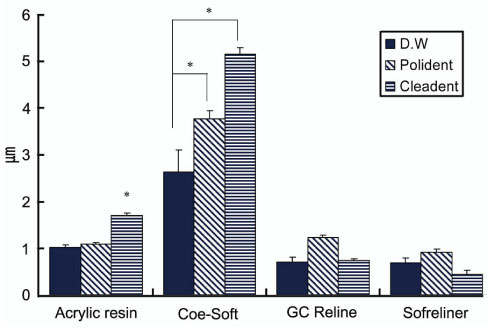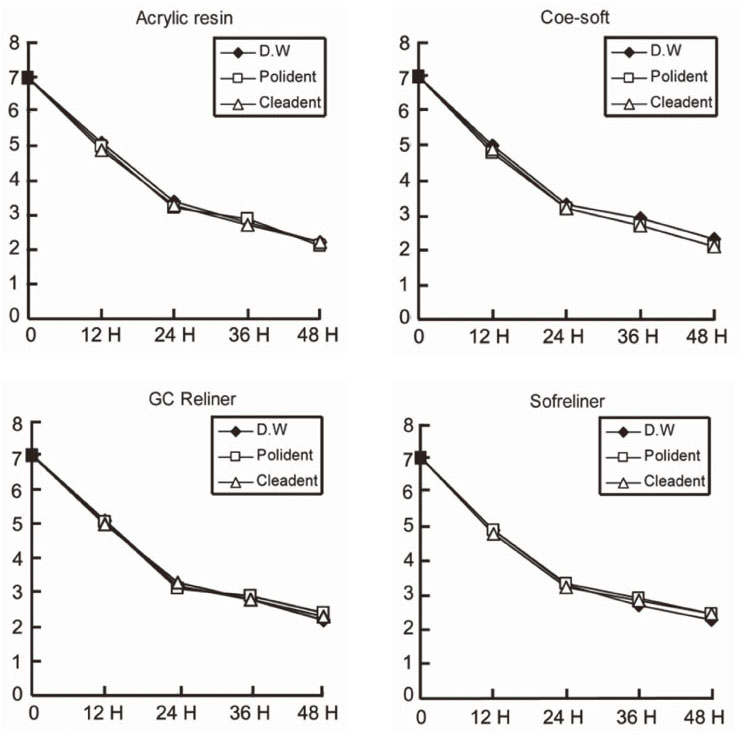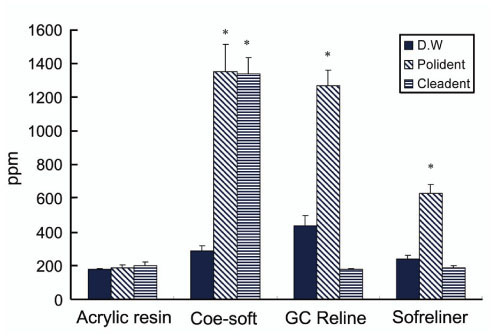J Adv Prosthodont.
2014 Apr;6(2):109-114. 10.4047/jap.2014.6.2.109.
Effect of denture cleansers on Candida albicans biofilm formation over resilient liners
- Affiliations
-
- 1Department of Prosthodontics, Busan National University, School of Dentistry, Dental Research Institute, Yangsan, Republic of Korea.
- 2College of Arts and Science, New York University, NY, USA.
- 3Department of Prosthodontics, Institute for Clinical Dental Research, Korea University Guro Hospital, Korea University, Seoul, Republic of Korea. swshin@korea.ac.kr
- 4Maxillofacial Prosthodontics, Head and Neck Institute, Cleveland Clinic, Cleveland, OH, USA.
- KMID: 2233338
- DOI: http://doi.org/10.4047/jap.2014.6.2.109
Abstract
- PURPOSE
The purpose of this study was to analyze the effect of denture cleansers on Candida albicans biofilm formation over resilient liners and to evaluate compatibility between resilient liners and denture cleansers.
MATERIALS AND METHODS
Acrylic resin (Lucitone 199(R)) and 3 resilient liners (COE-SOFT(TM), GC RELINE(TM) and SOFRELINER TOUGH TOUGH(R)) were incubated in denture cleansers (Polident(R) and Cleadent(R)) for 8 hours a day and in unstimulated saliva for 16 hours a day (n=25/gp) for 60 days. Two-way and three-way repeated measures ANOVA were performed to compare the surface roughness (Ra), pH and C. albicans binding level by radioisotope (alpha=0.05). The statistical significance of the relation between Ra and adhesion was evaluated by correlation analysis.
RESULTS
The degree of Ra was significantly decreased in the following order: COE-SOFT(TM), acrylic resin, GC RELINE(TM) and SOFRELINER TOUGH(R). The immersion in denture cleansers significantly increased Ra of resilient liners, except for SOFRELINER TOUGH(R) in Cleadent(R). No significant differences in pH curves were observed among groups immersed in distilled water and denture cleansers. The binding levels of C. albicans were significantly decreased in the following order: COE-SOFT(TM), GC RELINE(TM), SOFRELINER TOUGH(R), and acrylic resin. The immersion in Cleadent(R) seemed to decrease C. albicans binding level on GC RELINE(TM) and SOFRELINER TOUGH(R).
CONCLUSION
Based on the C. albicans binding levels results, it is not recommended to immerse COE-SOFT(TM) in denture cleansers, and GC RELINE(TM) and SOFRELINER TOUGH(R) should be immersed in Cleadent(R).
Keyword
MeSH Terms
Figure
Reference
-
1. Budtz-Jörgensen E. Clinical aspects of Candida infection in denture wearers. J Am Dent Assoc. 1978; 96:474–479.2. Bulad K, Taylor RL, Verran J, McCord JF. Colonization and penetration of denture soft lining materials by Candida albicans. Dent Mater. 2004; 20:167–175.3. Nikawa H, Iwanaga H, Kameda M, Hamada T. In vitro evaluation of Candida albicans adherence to soft denture-lining materials. J Prosthet Dent. 1992; 68:804–808.4. Nikawa H, Hamada T, Yamamoto T. Denture plaque-past and recent concerns. J Dent. 1998; 26:299–304.5. Nikawa H, Hamada T, Yamashiro H, Kumagai H. A review of in vitro and in vivo methods to evaluate the efficacy of denture cleansers. Int J Prosthodont. 1999; 12:153–159.6. Davenport JC, Wilson HJ, Spence D. The compatibility of soft lining materials and denture cleansers. Br Dent J. 1986; 161:13–17.7. Harrison A, Basker RM, Smith IS. The compatibility of temporary soft materials with immersion denture cleansers. Int J Prosthodont. 1989; 2:254–258.8. Goll G, Smith DE, Plein JB. The effect of denture cleansers on temporary soft liners. J Prosthet Dent. 1983; 50:466–472.9. Nikawa H, Iwanaga H, Hamada T, Yuhta S. Effects of denture cleansers on direct soft denture lining materials. J Prosthet Dent. 1994; 72:657–662.10. Verran J, Maryan CJ. Retention of Candida albicans on acrylic resin and silicone of different surface topography. J Prosthet Dent. 1997; 77:535–539.11. Waters MG, Williams DW, Jagger RG, Lewis MA. Adherence of Candida albicans to experimental denture soft lining materials. J Prosthet Dent. 1997; 77:306–312.12. Radford DR, Sweet SP, Challacombe SJ, Walter JD. Adherence of Candida albicans to denture-base materials with different surface finishes. J Dent. 1998; 26:577–583.13. Nikawa H, Jin C, Makihira S, Egusa H, Hamada T, Kumagai H. Biofilm formation of Candida albicans on the surfaces of deteriorated soft denture lining materials caused by denture cleansers in vitro. J Oral Rehabil. 2003; 30:243–250.14. Samaranayake LP. Nutritional factors and oral candidosis. J Oral Pathol. 1986; 15:61–65.15. Nikawa H, Jin C, Hamada T, Murata H. Interactions between thermal cycled resilient denture lining materials, salivary and serum pellicles and Candida albicans in vitro. Part I. Effects on fungal growth. J Oral Rehabil. 2000; 27:41–51.16. Nikawa H, Yamamoto T, Hayashi S, Nikawa Y, Hamada T. Growth and/or acid production of Candida albicans on soft lining materials in vitro. J Oral Rehabil. 1994; 21:585–594.17. Nikawa H, Hamada T, Yamamoto T, Kumagai H. Effects of salivary or serum pellicles on the Candida albicans growth and biofilm formation on soft lining materials in vitro. J Oral Rehabil. 1997; 24:594–604.
- Full Text Links
- Actions
-
Cited
- CITED
-
- Close
- Share
- Similar articles
-
- In vitro growth of candida albicans on several resilient dinture liners
- Evaluation of antibacterial activity against Candida albicans according to the dosage of various denture cleansers
- Effect of denture cleansers on surface hardness of resilient denture liners at various time intervals- an in vitro study
- Biofilm-forming ability and adherence to poly-(methyl-methacrylate) acrylic resin materials of oral Candida albicans strains isolated from HIV positive subjects
- Biofilm formation on denture base resin including ZnO, CaO, and TiOâ‚‚ nanoparticles




